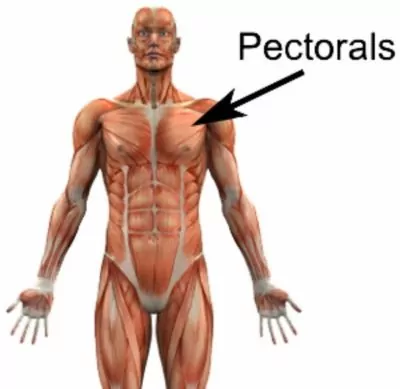Pectoralis Major Anatomy: Understanding the Muscles in Your Chest
Updated:
The pectoralis major is a large, fan-shaped muscle in the chest that is responsible for several important movements of the arm and shoulder. This muscle is commonly referred to as the “pecs” and is one of the most recognizable muscles in the body, especially in athletes and bodybuilders. In this article, we will explore the anatomy of the pectoralis major and how it functions in the body.

Pectoralis Major Anatomy
Origin:
The pectoralis major muscle originates from two separate areas: the sternum (breast bone) and the clavicle. The sternum is the bone in the center of the chest, while the clavicle is the collarbone that extends from the sternum to the shoulder. The upper fibers of the pectoralis major originate from the clavicle, while the lower fibers originate from the sternum.
Insertion:
The pectoralis major muscle inserts into the humerus, which is the long bone in the upper arm. Specifically, the muscle inserts into the bicipital groove, which is a shallow groove on the humerus that runs parallel to the bone’s long axis.
Action:
The pectoralis major muscle is responsible for several important movements of the arm and shoulder. These include:
- Adduction: When the arm is moved toward the body, the pectoralis major muscle contracts to pull the arm in.
- Flexion: When the arm is moved forward, the pectoralis major muscle contracts to bring the arm forward.
- Internal rotation: When the arm is turned inward, the pectoralis major muscle contracts to facilitate this movement.
Nerve Supply:
The pectoralis major muscle is innervated by the medial and lateral pectoral nerves. These nerves arise from the brachial plexus, which is a network of nerves that originate from the spinal cord and provide motor and sensory function to the arm and shoulder.
Blood Supply:
The pectoralis major muscle is supplied with blood by the thoracoacromial artery and the pectoral branch of the thoracoacromial artery. These arteries originate from the axillary artery, which is a major blood vessel in the shoulder.
Common Injuries:
The pectoralis major muscle is subject to several types of injuries, including pectoral strains and tears. These injuries can occur as a result of overuse, direct trauma, or sudden, forceful movements. Symptoms of a pectoralis major injury may include pain, swelling, bruising, and weakness in the affected arm and shoulder.
Pectoralis Major Anatomy – Conclusion:
In conclusion, the pectoralis major muscle is a large, powerful muscle in the chest that plays an important role in arm and shoulder movements. Understanding the anatomy and function of this muscle can help patients to better understand their body and how it works. If you are experiencing any symptoms of a pectoralis major injury, it is important to seek medical attention from a qualified healthcare provider.
Pectoralis Major Anatomy – References:
- Drake, R. L., Vogl, W., & Mitchell, A. W. M. (2015). Gray’s Anatomy for Students. Elsevier Health Sciences.
- Moore, K. L., & Dalley, A. F. (2014). Clinically Oriented Anatomy. Lippincott Williams & Wilkins.
- Palastanga, N., Soames, R., & Palastanga, D. (2012). Anatomy and Human Movement: Structure and Function. Elsevier Health Sciences.
- Standring, S. (2016). Gray’s Anatomy: The Anatomical Basis of Clinical Practice. Elsevier Health Sciences.
- Tortora, G. J., & Derrickson, B. (2017). Principles of Anatomy and Physiology. John Wiley & Sons.
- Muscles of the pectoral region by Teach Me Anatomy – https://teachmeanatomy.info/upper-limb/muscles/pectoral-region/

Link to this Page
If you would like to link to this article on your website, simply copy the code below and add it to your page:
<a href="https://physioadvisor.com.au/pectoralis-major-anatomy-understanding-the-muscles-in-your-chest”>Pectoralis Major Anatomy: Understanding the Muscles in Your Chest – PhysioAdvisor.com</a><br/>Learn about pectoralis major anatomy including origin, insertion, action, nerve supply, blood supply, common injuries on PhysioAdvisor.
Return to the top of Pectoralis Major Anatomy: Understanding the Muscles in Your Chest.
